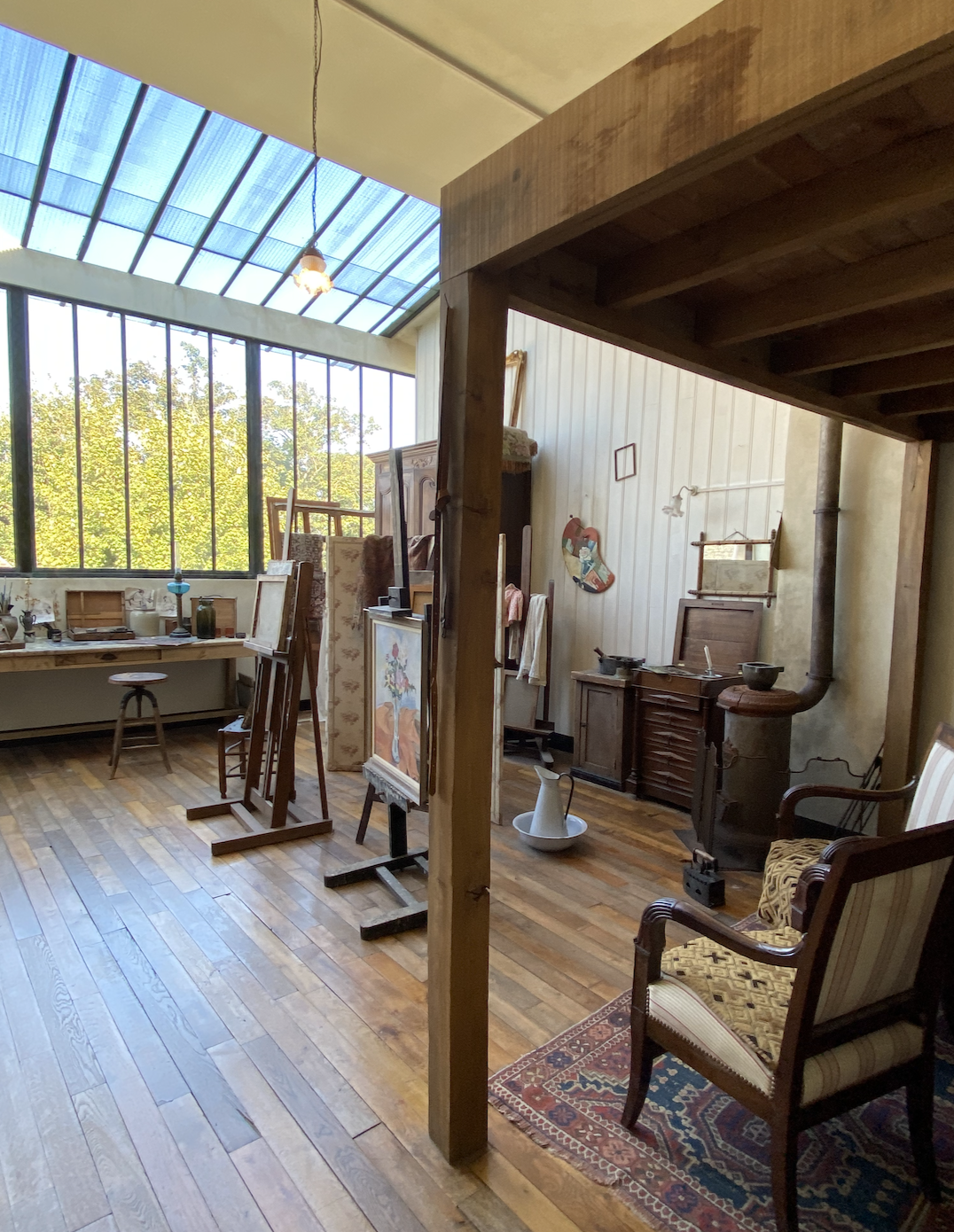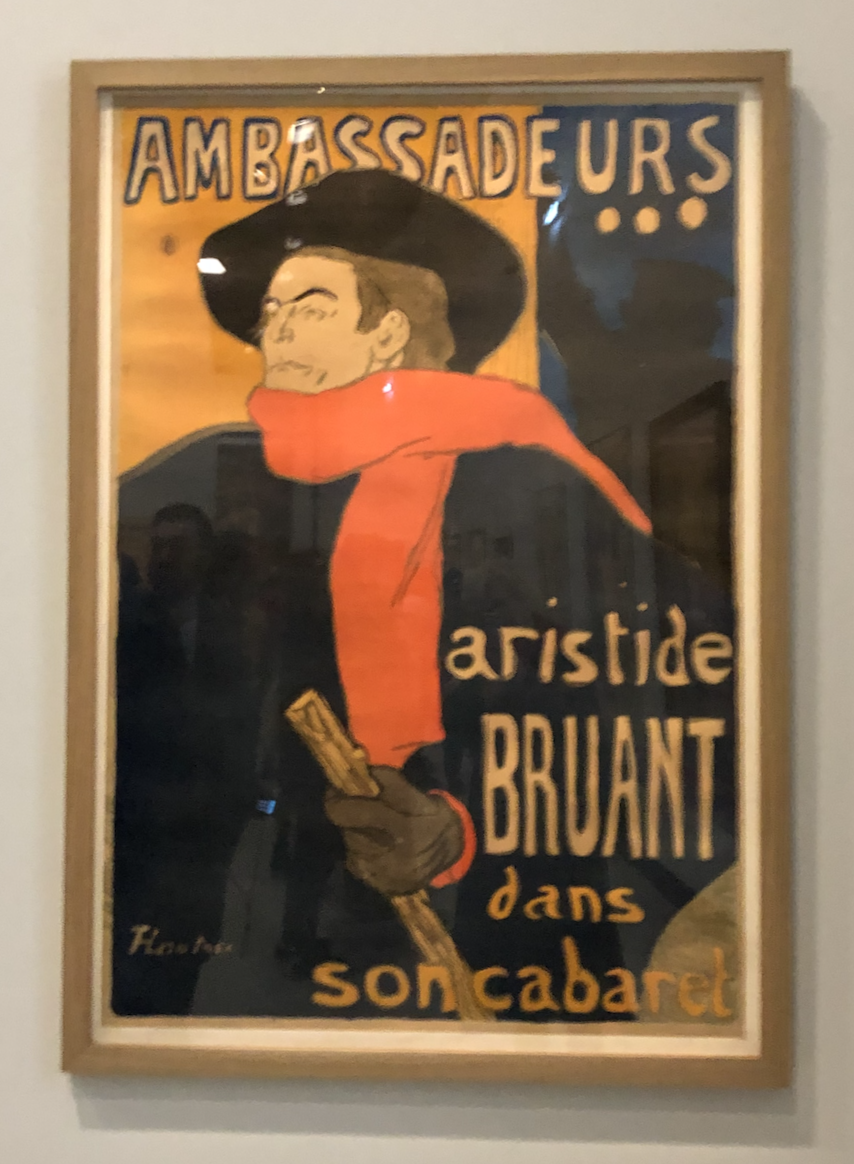Miss the walk live, watch it here in YouTube
One of the loveliest small museums in Paris is the Musée de Montmartre on the Rue Cortot. The 16th-century buildings are a few of the oldest on the hill of Montmartre and were once the homes of a few of the greatest French artists. The Hotel Demarne was once the home of Claude de la Rose, a great actor in the time of Moliere. Pere Tanguy, the wonderful and kind pa
int crusher lived here for a short time and supplied all the artists with their precious pigments.
The museum was inaugurated in 1960. In 2012 the Jardin Renoir was redone and inspired by the paintings he created here. La Balançoire and the Jardin de la Rue Cortot. He also painted Bal du Moulin de la Galette here
The museum is made up of a few separate buildings, In the Hotel Bel Air, holds even more fantastic French history. And sits down the hill just a bit, It was here that Renoir set up his studio. In the lovely Jardin Renoir, you will find a few recognizable views including the tree swing that he painted in 1876. Jeanne Samary, his frequent model, stands on the swing that is still in the same spot today and is marked with a plaque.
On October 14, 2014, the museum reopened after a multi-year renovation. The Café Renoir was added and is a great place to stop for an afternoon coffee or rosé.
Make sure you go inside the museum and up to the former studios of Suzanne Valadon. Inside the studio that is exactly how she had it as evident in the photos. Her son Maurice Utrillo and his friend/her lover André Utter also lived with her. Her small bedroom is to the right as you come up the stairs. You step right into the life of the model turned artist that also had a fascinating life of ups and downs.
She was the very first podcast episode we did and is worth a listen if you want to know more about her.
The Musée de Montmartre is open daily 10 am-7 pm
The view from the backyard is a peek into the vineyard of Montmartre. Vineyards were found as far back as the mid-10th century on the hill and planted by the Abbaye of Montmartre.
In the 17th century Gabrielle d’Estrées, mistress and love of Henri IV had a home here and the nearby Le Parc de la Belle Gabrielle cabaret. Gabrielle’s cousin Claude was once the Abbess of the Abbaye and lover of Henri IV before Gabrielle,
It wasn’t until 1860 that Montmartre was annexed into Paris, and before that the vineyards and bars were free from the big city taxation. It is also why all the artists lived here, the wine was cheap.
Singer Aristide Bruant, subject of Toulouse Lautrec lithographs lived here until his death in 1925. A small park next to his house was a favorite for TL to sit in. After Bruant’s death, the city of Paris bought the property
In 1932, Pinot Noir vines from Thomery, in the Seine-et-Marne were planted. In 1933 the Clos-Montmartre was created. Their office is just over the hill on Rue Lepic in the octagon-shaped building across from the Folie Sandrin
La Commanderie du Clos Montmartre was a former water tower and reservoir built in 1835 to replace a hunting lodge of Catherine de Medici. The Neoclassical structure was designed by Titeux de Frosny and once pumped up water from the Seine in Saint Ouen to serve the area. The water pump was decommissioned in 1927 and the octagonal-shaped building later became the office of the Commanderie du Clos Montmartre
The first harvest was in 1934 as well as the first celebration that is still done each year is in October. The wine is horrible
Rue Cortot, was named after the French Neo-Classical artist Jean-Pierre Cortot. Many of his sculptures can be found in the Musée du Louvre and the Louis XIII statue in the center of Place des Vosges as well as the Statues of Rouen and Brest in the Place de la Concorde. Vivant Denon commissioned Cortot to create a monumental statue of Napoleon for the top of the Arc de Triomphe de Carousel, Napoleon squashed the idea.
Just outside the door at no 6 lived Erik Satie. The composer who wrote one of the most beautiful pieces in the world Gymnopédie no 1. Satie and Valdon were lovers from 1890 to 1898 and you can say he was obsessed with her. She decided to move on to one of his close friends Paul Mousis who she married but later left for her son's best friend. Quite the small circle there Suzanne.
At the top of the street, the Chateau d’Eau Montmartre crowns the back side of the hill inside the Square Claude Charpentier. Architect Charpentier was born in 1909 and dedicated his time to restoring and protecting historic structures in the Marais, Montmartre, and around the Sorbonne.
Rue des Saules, named for the fact it was once lined with willow trees.
Maison Rose was once owned by Germaine Pichot and her husband Ramon. The one-time dancer was the love interest of Carlos Casagemas, a close friend of Picasso. Carlos fell in love with her but the feeling wasn’t mutual. On February 17, 1901, Carlos walked into the Hippodrome Cafe in Pigalle where he was holding a dinner party and attempted to shoot Germaine before he turned the gun on himself. This tragic event sparked Picasso’s prolific blue period where Carlos was the subject of many of the pieces.
Rue de l’Abreuvoir originally an alley dating back to 1325. Now it is one of the most photographed streets in Paris for its view up to the backside of Sacre Couer
At no 4, the Maison des Aigles is one of the oldest buildings on this side of the hill. Once the home of Henri Lachouque, 1883-1971. Officer and decorated with the legion d’honneur award he was a dedicated historian of Napoleon and the 1st empire.
Notice the sundial
Quand tu sonneras, Je chanteray. when you ring I will sing
The Place Dalida was renamed in 1997 when a bust of the star was installed marking the tenth anniversary of her death. Artist Alain Aslan created the bronze bust that is often rubbed for good luck and also created the amazing statue on her tomb in the Montmartre cemetery. Check out the episode of Paris History Avec a Hemingway for more on the life of Dalida.
The street leading away from the Place Dalida, Rue Girardon is named after Francois Girardon who was a sculptor under Louis XIV who first worked for Nicolas Fouquet on Vaux le Vicomte. Girardon created the tomb of Cardinal Richelieu in the chapel of the Sorbonne and a statue of Louis XIV that once stood in the center of Place Louis Le Grand, now Place Vendome. A small version is all that remains in the Musée du Louvre. Also in the Louvre are a few of his sculptures on the ceiling of the Galerie d’Apollon and a tapestry portrait of him hangs on the wall with a bit of the tomb of Richelieu.
Just down the Escalier de la rue Girardon.
At the bottom of the stairs is the Square Joël Le Tac named for the French resistance fighter born towards the end of WWI. Tac was a teacher until 1939 when mobilized but refused to go to the front. He instead trained soldiers and was involved in the first paratrooper unit. After the war, he was a journalist for Paris-Presse and then as a deputy in the new government formed by De Gaulle from 1958-1981.
The square was created in 1935 and renamed on February 2, 2012
At the entrance from the stairs is a monument to Théophile Steinlen. A Swiss artist born November 20, 1859. In 1881 Steinlen and his wife Emilie moved to Paris and in 1883 to Montmartre where they remained for the rest of their life. Steinlen knew Toulouse-Lautrec and hung out at Le Chat Noir and created the now very famous image used on everything from towels to magnets.
Paul Vannier created the monument in 1935. The stone statue is of Théophile and Emilie and was placed here as they often sat here every evening. The bronze bas relief plates were melted down by the Vichy government in 1942 and later replaced in 1962.
Just past the Square Joel le Tac is the Place Claude-Nougaro named on the 15th anniversary of his death on November 28, 2019. Born in 1929 in Toulouse to an Opera singer father and a piano teacher mother. He first appeared on the stage of the Lapin Agile in 1954 and went on to become a beloved French singer.
Towards the end is a statue of artist Eugène Carrière who lived from 1849-1906. Friends with Rodin he started the Carrière Academie on the Rue de Rennes and counted Matisse as a student. The statue was created in 1932 by Henri Sauvage. The bas-relief plates represent the works of Carrière as well as a poem on the origins of emotions.
The plates were also melted down in 1942 and replaced in 1949 by Jean René.
Ahead on the corner of Rue Caulaincourt and Avenue Junot is an Histoire de Paris sign marking Le Maquis. Until the end of the 19th century, this area was known as Le Maquis and covered in small alleys, houses, and gardens. The artists loved the area and many including van Gogh, Modigliani, and Steinlen lived in the neighborhood. Much of it disappeared gradually at the beginning of the 20th century as Avenue Junot was enlarged.
At Number 73 Renoir lived from 1902-1903, Theophile Steinlen also lived here until his death. Steinlen also lived at number 58 before moving to 73.
The Rue Caulaincourt is named for the great French marquis, Armand Augustin Louis de Caulaincourt who served under Napoleon and was ambassador to Russia.
We end at the Square Caulaincourt, which is actually a street but not open to cars. The set of 112 steps leads down to the Rue Lamarck. It’s best to go down instead of up
Walk Route:
Jardin Musee Montmartre
Out the door and to the left briefly to the building next door
Back down Rue Cortot
Right on Rue des Saules
Left on Rue de l’Abreuvoir
Place Dalida
Down steps to the right
Place Joel le Tac and monument
Take a left on Caulaincourt
Place Claude Nougaro
Rue Caulaincourt
Right on Square Caulaincocurt
End there












